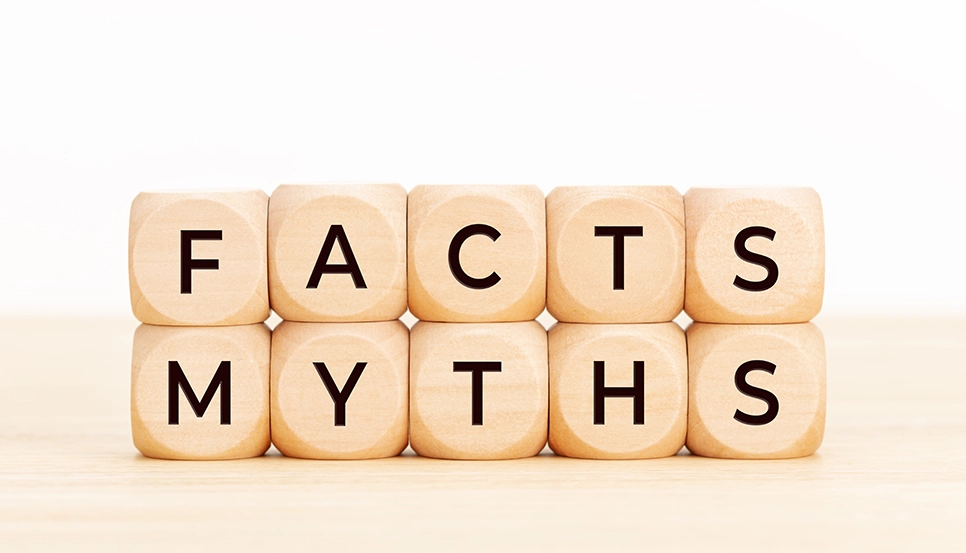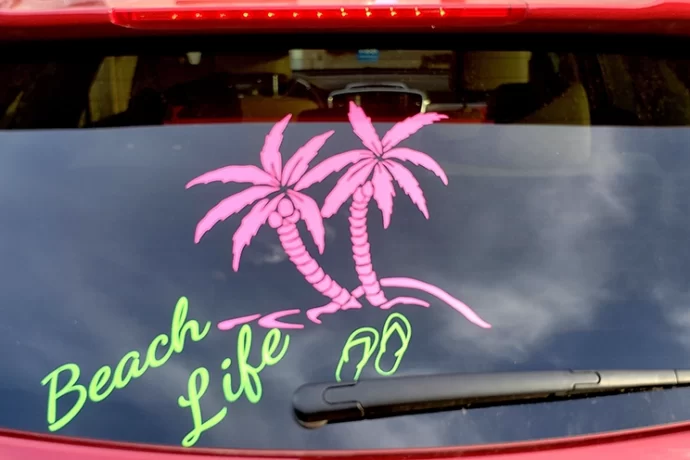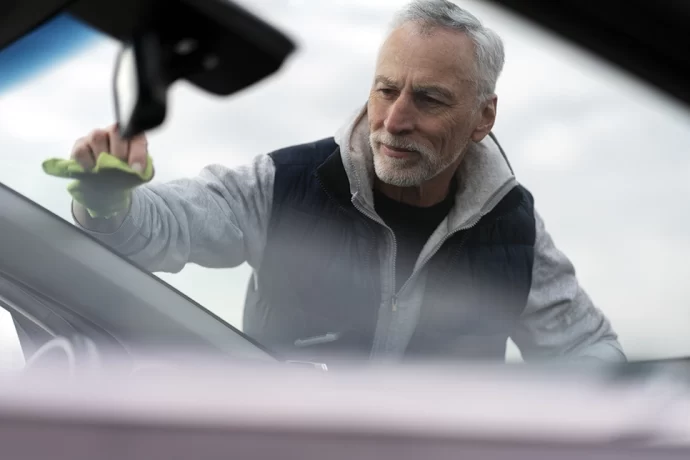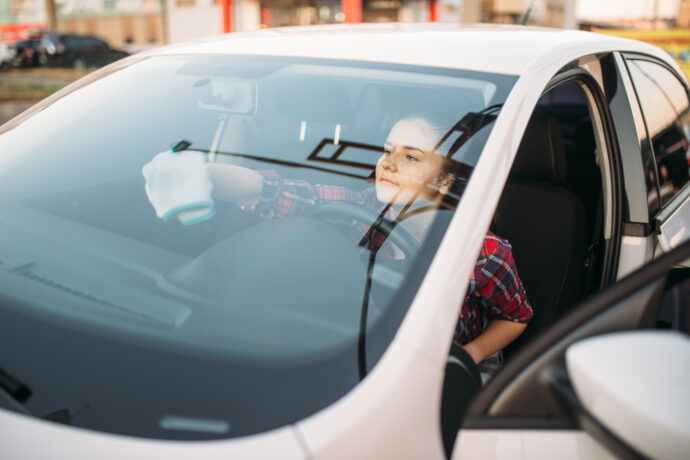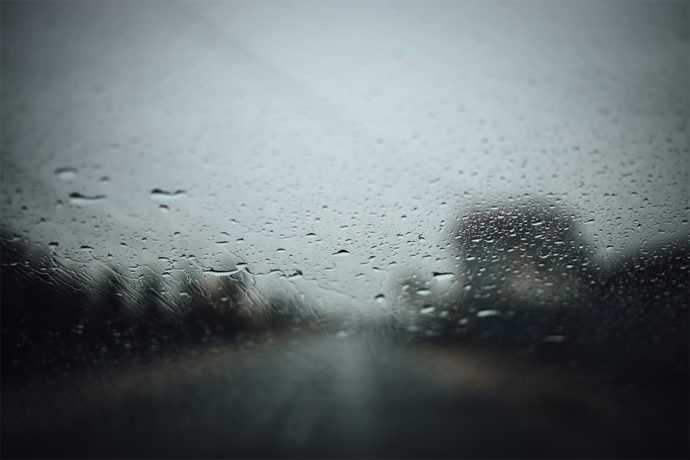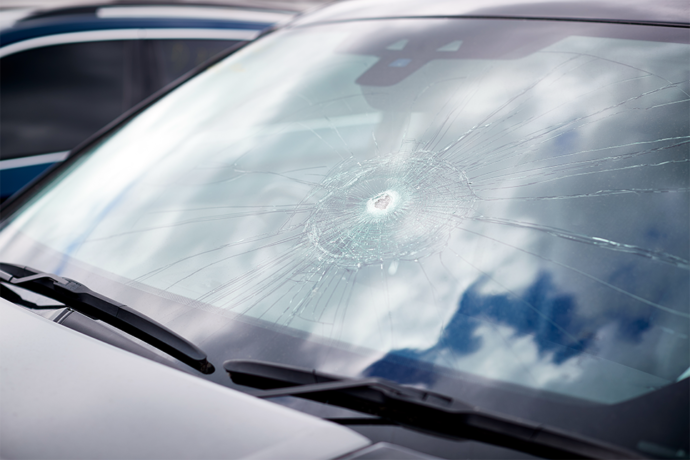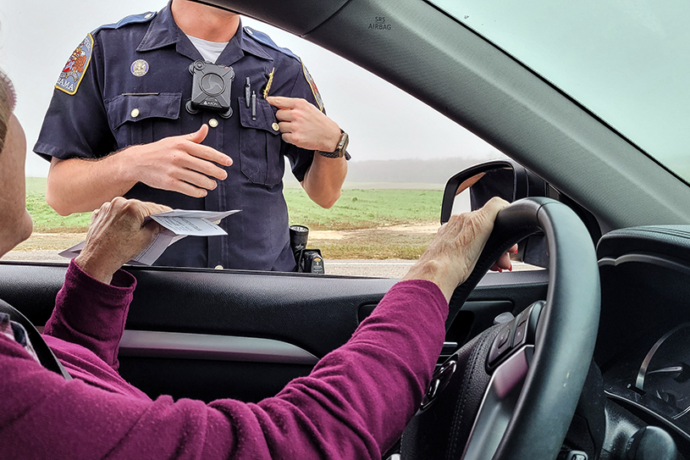Windshields endure endless abuse on the road from debris of all kinds. It’s no wonder myths and misconceptions also bombard our car’s first line of defense. Can windshield glass really stop a bullet? Do center cracks obstruct vision more than edge cracks? Does tinted glass provide extra impact protection? The fiction swirling around windshields could leave your knowledge just as cracked as the damaged glass itself!
Thankfully for Denver drivers, the auto glass experts at Precision Auto Glass are here to set the record straight. In this myth-busting guide, we tackle some of the most prevalent fallacies some people believe about the strength, repair limits, and protective qualities of their windshields. We’re dishing out revelations backed by physics, federal safety standards, and industry insider perspectives.
So, let’s separate fantasy from reality on the glass protecting the interior of your vehicle.
Myth #1: A Windshield is Bulletproof
A dramatic movie scene has bullets pinging off a car’s windshield, sending cracks through the glass as the hero takes cover behind an impervious barrier. The mythical idea gets planted – “My consumer auto windshield can stop bullets and protect me too!” While safety glass technology has made great strides, standard vehicle windshields still cannot reliably deflect bullets and ballistic impacts. Why the discrepancy between Hollywood fantasy and reality?
Several factors determine if a windshield deters or fails against live ammo, including the velocity, angle of incidence, caliber, and construction of particular bullets. Most consumer auto glass is designed to withstand typical small debris impacts while driving, not point-blank terminal ballistics. According to industry experts, standard laminated windshield construction could theoretically stop very low-velocity rounds striking at very shallow angles. However, the National Highway Traffic Safety Administration found resistance sharply diminishes as PROJECTILE speed, mass, and strike angle increase against common forms of safety glass.
For context, average handgun bullets travel between 700 to 1,400 feet PER second. The kinds of safety glass and transparency polymers used in regular auto windshields are no match for the concentrated kinetic energy and hydrostatic shock waves produced by hyper-velocity rounds. The glue laminating windshield layers likewise fails to retain overall integrity when fractured at ballistic velocities. Simply put, relying on standard auto glass as improvised armor even against low-power handguns can prompt tragic outcomes.
While advancements in bullet-resistant glass continue for military and security vehicles, mainstream consumer windshields cannot yet achieve this degree of impenetrability. So leave the bullet dodging theatrics to the Hollywood stars! Responsible drivers should downgrade those popular action movie scenes to sheer science fiction and get a windshield replacement if their glass suffers ballistic damage. Focus on safe driving habits rather than fantasies of magically bulletproof glass.
Myth #2: The Quality of OEM Windshields and Aftermarket Windshields Is the Same
The windshield replacement quote from Brand X is hundreds less than an OEM glass quote. Tempting? Perhaps, but think twice before settling for aftermarket low quality, no-name knockoffs.
Many drivers assume the discount generic windshield can’t possibly offer comparable quality and safety to OEM parts from the vehicle manufacturer. Are these suspicions reality when it comes to aftermarket glass meeting safety specifications?
While OEM branded windshields are crafted to maximize visual clarity and proper contour fit for each car make and model, federal requirements still regulate aftermarket replacement glass quality too. All windshield manufacturers supplying the U.S. auto glass market must comply with Federal Motor Vehicle Safety Standard 205, mandating impact, structural integrity, and fragmentation testing on par with OEM.
However, the compliance with minimum benchmarks still allows some aftermarket brands to cut corners on optical clarity, longevity, resins, and overlay materials. Technicians may also lack specialized training and equipment to seamlessly install generic glass on more complex vehicle shapes. So while aftermarket windshields meet baseline impact safety requirements, shelling out a bit more for OEM parts guarantees optimal restoration of visual acuity and form fitting.
In the eyes of federal regulators, aftermarket windshields aren’t necessarily substandard across the board. But our eyes discern the difference in materials, fitment finesse, and long-term performance compared to precision-engineered OEM glass. We advise paying extra for the quality assurance and vision-preserving properties that brand name windshields uniquely deliver. Don’t shatter your clarity standards by automatically equating federal compliance with equally flawless vision care from low-quality aftermarket parts.
Myth #3: Tinting Strengthens Auto Glass
Many drivers believe adding a tinted film over their windshield or other auto glass adds a layer of strength and damage resistance. It’s easy to assume an extra coating shields the actual glass underneath from chips and cracks. This intuition crashes head first into the reality that tinting does not physically reinforce or “strengthen” windshield glass in any significant way. Where does this myth originate from and what actually bolsters impact resilience in auto glass?
Tint films, absent any thickness or integrative bonding, hover over the outer windshield surface without penetrating its core structural layers. Leading manufacturers 3M and Llumar confirm that aftermarket tint alone does not measurably boost glass strength or affect internal cohesion. The misperception likely stems from tint’s adjacent benefits limiting glare and UV rays that deteriorate dashboards and vehicle interiors over time. However, mitigating sun damage and eye strain differs enormously from boosting the intrinsic ability to withstand debris impacts and spreading cracks.
So what does tangibly toughen windshield glass? Innovations like acoustic polymer layers, structural composites, and advanced chemical strengthening of the internal glass material itself actively thwart both small and large impacts. Newer laminated windshield constructions better disperse concussive force rather than just blanket the glass under a superficially darker facade provided by tints. While the marginal glare and heat reductions from tinting deliver some upside, windshield glass derives its lifesaving resilience from emerging structural technologies inside the glass, not surface films outside it.
Myth #4: You Can Fix a Windshield Crack With Super Glue or Clear Nail Polish
It’s tempting to grab whatever adhesive is conveniently lying around the house when you notice a small windshield crack that wasn’t there yesterday. Clear nail polish. Super glue. Surely something so strong can fix the crack for good, right? Unfortunately, quick home fix attempts using basic household adhesives only yield short-term bandage solutions compared to professional resin repairs.
While super glue may shallowly seal the outer layer debris near a fissured area in glass, its liquid properties fail to adequately penetrate and fill the deeper structural fractures within damaged windshields where weaknesses concentrate most. Additionally, inept application leads to visible clouding or crystallization around cracks over time from sun exposure; an opaque distraction while driving versus crystal clear professional resin results that restore optics and strength.
Much like brushing on a layer of nail polish over nail cracks, these superficial quick fixes hovering over glass cracks rather than filling their depths cannot integrate enough consistent internal support to prevent existing damage from worsening over bumps or temperature shifts. The unreliable bonds also crack again easily under stress. Amateur aesthetics briefly disguise broken structural mechanics in dire need of professional attention underneath — don’t gamble on makeshift chemistry experiments with the clarity and safety of your windshield.
While tempting for instant gratification, low viscosity household adhesives lack the durable seal and transparency that pressure-injected auto glass repair resins provide to comprehensively reinforce compromised windshields long-term. Save DIY plans for Pinterest crafts rather than do-it-yourself auto glass repair calamities! Protect vehicle visibility and avoid accidents by getting cracks expertly filled the first time. Contact Precision Auto Glass for professional windshield crack repairs using premium resins that durably fortify weakened glass integrity neglected by casual home fixes.
Myth #5: Center Windshield Cracks Are the Most Hazardous
Conventional wisdom preaches that cracks stemming from a windshield’s center outward obstruct vision worse than peripheral cracks. This narrow focus crashes blindly into the larger reality that cracks distort sightlines regardless of location; edge, sides, bottom, or dead center. No “minor” cracks exist for safe driving. We demonstrate why ALL windshield fractures require swift repairs.
While centrally originating cracks may cross directly over typical focal points, seemingly smaller spidering cracks migrating from edges or corners still impair critical viewing angles. Cracks interrupting just a small percentage of lower windshield visibility still exponentially increase odds of missing traffic lights or pedestrian hazards while scanning the road. Field of vision relies on uninterrupted continuity.
Whether cracks source from stray perimeter debris impacts or the notorious “cone crack” formations radiating outward from previous repairs gone awry, any fractures degrading optical clarity get treated equal. No inconsequential cracks! We caution placing false confidence in safely navigating around mushrooming cracks drifting in from windshield edges over time. Gradual tunnel vision creeps up unnoticed; don’t realize distortions until disaster strikes.
Remember, ruthless temperature shifts and road vibrations constantly work to open cracks wider no matter where they start from. Stay proactive to avoid being reactive crash victims. Don’t base repair urgency solely on crack origins when all fractured glass equally threatens safety over time. Get out ahead by having Precision Auto Glass swiftly restore pristine vision quality across your windshield glass, edge to edge and top to bottom!
Myth #6: You Can Scrub Out Windshield Scratches
It’s a tempting theory – you can just scrub out that scratched glass or pesky windshield chip with some good old elbow grease and soap. Driver hopes spring eternal that somehow gritty debris causing visibility issues gets dislodged by wiper blades or dissolve in washer fluid. Unfortunately, reality won’t wash away embedded windshield cracks and defects so easily. While vital for clarity around existing flaws, washing never permanently reverses actual glass deterioration.
Pressure washing essentially attacks the visible symptoms rather than the underlying breach in the windshield surface. Soap solutions can’t penetrate and fill fractured glass integrity the way specialized resin repairs do. At best, vigilant cleaning removes some loose residual chips or adjacent dirt around cracks to improve sightline clarity in the short term. Long term though, lingering cracks still spread inevitably from stress factors if left untreated.
While pristine maintenance keeps additional debris from clouding views, core structural weakness persists allowing cracks and pits to channel deeper over bumps and temperature shifts.
For cleaning agents to even have a fighting chance at restoring views, the underlying glass damage necessitating removal must get repaired by professionals first. Washing alone simply cannot undo fractures down to the molecular level.
Keep the windshield surface immaculate, yes, but also schedule repairs for vision clarity and safety. Partner vigorous cleaning habits with fixing cracks and defects rather than hoping washing alone can whisk away serious visibility issues. Don’t soak in myths; contact Precision Auto Glass to repair glass flaws and provide long-lasting clarity.
Myth #7: Factory Windshields Never Leak
You buy a vehicle believing that the windshield will deflect rain eternally. Unfortuntely, most adhesives cannot fully prevent occasional leaks between glass and car bodies indefinitely. What factors enable water intrusion after replacement?
The main culprit remains vehicle frame design from auto manufacturers rather than the wrong adhesive choice per se. Many vehicles feature a contoured fit between body and glass impossible to seamlessly seal perfectly across all miles and climate conditions. Gaps are inevitable. Thus allowing moisture migration opportunities when wind flows push rain past adhesive barriers.
Additionally, your windshield adhesive constantly battles against temperature differentials pulling at the bonded seal. Freezing overnight cold contracts auto body steel more extremely than layered windshield glass, disturbing ideal mating. Heat flexes components inconsistently too. Such scheduled and impromptu shifts constantly tug and stress proofing adhesives over time.
When it comes to windshield replacements, problematic leaks most likely originate from factors beyond an installer’s control, but reputable auto glass shops test for optimal seal integrity by pressure spraying replacements and making minute fit adjustments during initial adhesion. They also apply durable modern polyurethane glues that maintain elasticity versus cheaper rigid pastes prone to shrinking and cracking. Though unable to guarantee 100% future waterproofing, conscientious technicians maximize impermeability odds early on.
In the end, a false perception of guaranteed leak proof windshields for all time remains just that – false. But the best installers combine savvy material selections and meticulous placement to significantly minimize moisture migration over the long run. Partner with Precision Auto Glass auto glass specialists committed to attenuating leak risks using ideal adhesives and meticulous mounting procedures.
Myth #8: European Cars Require OEM Glass
Drivers seeking windshield replacements for prized BMWs, Audis, and Mercedes get scared off by dealers quoting OEM factory branded glass as mandatory to avoid fit compatibility issues or ruining manufacturer structural integrity. Surely no Mercedes can stoop to accept aftermarket glass right? This myth ignores that reputable aftermarket windshields, wherever installed, fully meet all federal impact safety and durability standards – easing cost angst.
Per Federal Motor Vehicle Safety Standard 205’s uniform guidelines, aftermarket windshields endure the same barrage of extreme temperature, light transmittance, chemical, damage, and crash simulations during certification processes. Parts passing earn permanent markings attesting compliance. It’s why insurance companies cover aftermarket glass. This reliability transfers over when servicing German vehicles too, however lacking aesthetic logos of luxury brands on replacement glass.
Savvy consumers realize opting for costlier dealership OEM glass on European models brings some perks like perfectly matching factory curvature specifications for seamless installations and retaining visible manufacturer markings along bottoms typifying the prestige marque. However, discounting all non-branded windshield part alternatives as universally deficient on imported vehicles misses reality. Aftermarket windshields satisfying FMVSS 205 testing ensure lasting fit and safety at economic pricing for budget buyers.
Getting luxury car windshield quotes undoubtedly succumbs to assumptions only pricey OEM glass fits immaculately while visibly aligning with your vehicle’s posh aesthetics and stringent rehabilitation demands. Yet, validated aftermarket windshields provide massive savings without compromising compliance to critical safety measures or restoration needs. Dispel the fiction only OEM parts work on vehicles overseas!
Don’t Crack Under Windshield Myths
We’ve tackled some prevalent fiction swirling around windshield strength, repair limits, protective qualities, and replacement expectations. Without the facts, it’s easy to shatter consumer knowledge on the auto glass safeguarding vehicles every day. Now envision clarity with these myth-busting takeaways:
Myth: Ordinary windshields can stop bullets
Reality Check: Ballistic resilience requires heavy, expensive specialty glass
Myth: Aftermarket windshields are automatically substandard
Reality Check: Aftermarket windshields still must meet federal regulations but stick with reputable brands
Myth: Tints structurally reinforce windshield glass
Reality Check: Window tint does not strengthen glass in any meaningful way
Myth: Home DIY repairs permanently fix cracks
Reality Check: Only professional resin injection penetrates deep damage and properly fixes cracks
Myth: Only center cracks necessitate quick repairs
Reality Check: ALL cracks progressively impair visibility and need repair
Myth: Washing can repair chips and cracks
Reality Check: Cleaning maintains clarity but cannot undo glass flaws
Myth: Adhesives prevent windshield glass leaks forever
Reality Check: Vehicle factors challenge lifelong seals
Myth: European models need OEM glass
Reality Check: Reputable aftermarket windshields pass federal specs
The windshield remains one of the most crucial yet misunderstood safety components shielding vehicle occupants. Don’t undermine personal safety with fiction and myths! Consult reputable specialists like Precision Auto Glass to truly understand windshield protection limits, repair best practices, and replacement procedures specifically optimized for your vehicle’s unique demands. Protect yourself beyond myths!

